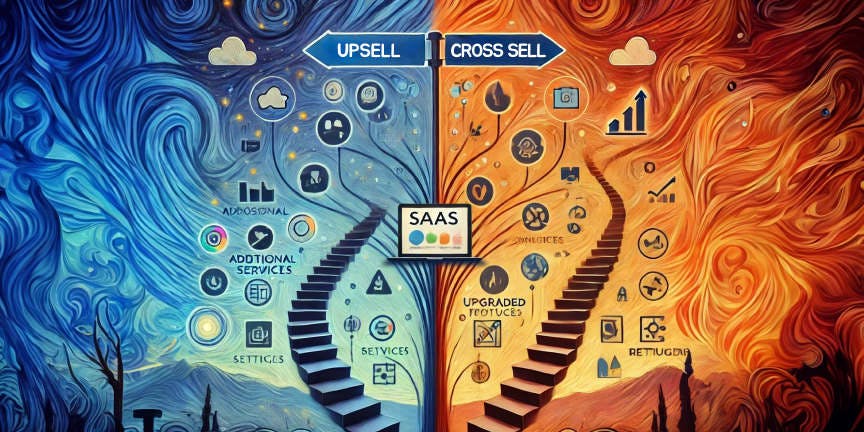Upselling and cross-selling are two powerful strategies for increasing revenue in SaaS businesses. Upselling encourages customers to upgrade their current plans. Cross-selling, on the other hand, promotes complementary products or features.
Both approaches significantly impact your brand's success. But which SaaS marketing strategy is right for you?
Hence, we will look at Upsell vs Cross-Sell SaaS strategies in this article. Each can impact your profits and deliver more value to customers.
What is Upselling in SaaS?
Upselling in SaaS is a sales strategy where you offer customers an upgrade from the paid plan to a more expensive one. A common example is a Netflix subscription. For more money, they upgrade you, allowing more users to stream simultaneously for an additional cost.
Offering customers choices is a classic sales strategy. Companies use it to boost sales. One key strategy that takes this tactic to the next level is offering premium features to the same model. This is what upselling is all about.
Upselling typically happens in two ways:
- Offering existing customers a higher plan than their current one.
- Encouraging new customers to choose a more advanced plan than they originally intended.
This is how upselling generates higher revenue for your organization.
Top 3 Popular Examples of SaaS Companies Using Upselling
1. Dropbox
The upsell strategy includes the promotion of paid plans by pointing out the limits of its free version, like less storage and basic features. With this approach, the company encourages users to upgrade more storage, and extra collaboration features (smart sync, file versioning, and shared link controls). This makes Dropbox more useful for businesses or professionals.

2. Spotify
As part of an upselling strategy, Spotify limits some important features in its free version, like offline listening and ad-free music. With this approach, free users experience ads and can’t download songs for offline use. By upgrading to Premium, users get uninterrupted listening, better sound quality, and the ability to download music for offline access. This makes the Premium service more attractive and convenient for users.

3. Slack
Inspires users to upgrade to paid plans by limiting the free version's features. Free users can only view a limited message history and have restricted app integrations. As teams grow and their needs increase, opting to upgrade is the only solution. Upgrading to a paid plan offers unlimited message storage and more app connections. This upselling strategy naturally pushes users toward paid options.

What is Cross-Selling in SaaS?
Cross-selling in SaaS implies offering extra non-essential products or features. They enhance the value of the original purchase.
These offers benefit users more, improving overall satisfaction and increasing revenue.
For example, after buying an iPhone, you're offered a charger and other accessories—the same idea applies in SaaS!
Hence, the customer will have multiple options to choose from. Customers feel better when they are offered different options. That way, they feel more liberated about their choices. A downside to that is also the confusion of deciding what to pick from the availability of multiple choices to the consumer. This is how cross-selling leverages business revenue.
This approach gives customers more choices, enhancing their experience while boosting your revenue.
However, having too many choices can sometimes cause confusion. Thus, plan your cross-selling efforts carefully to make it easier for customers to decide. Try to offer discounts to new customers and use targeted sales calls or marketing campaigns for existing customers. This will surely increase the Average Order Value (AOV).
Top 3 Popular Examples of SaaS Companies Using Cross-Selling
Here are the 3 popular SaaS companies that use cross-selling strategies:
1. HubSpot
Uses a cross-selling strategy with the promotion of how well their products work together. For example, if you're using HubSpot's CRM, you are also interested to try their email marketing tools. These tools are already set up to work perfectly within the CRM, making it easier to run more efficient campaigns. By highlighting this smooth integration, HubSpot nudges users to adopt more of their services for better results.

2. Zendesk
The approach is to identify the necessary gaps in customer service by analyzing all the support tickets. After examining the gap every time, the company offers unique cross-sells ideas, such as Chat or Zendesk Talk, as ways to engage with customers in real-time. Thus, improving resolution times and overall satisfaction.

3. Salesforce
Uses cross-selling by offering companies like Deloitte and Wipro additional tools like Marketing Cloud or Service Cloud. These tools integrate seamlessly with Sales Cloud, providing a full view of customer interactions. This also, helps companies improve relationships by managing sales and support.

Differences Between Upselling and Cross-Selling in SaaS
While both upselling and cross-selling help boost revenue, they each serve different purposes. Let’s break it down:
Upselling | Cross-Selling |
|---|---|
Customers upgrade to higher subscription plans for access to premium features. | Customers purchase additional tools, modules, or services to increase product efficiency. |
Upselling can be performed before or during the subscription renewal process. | Once the initial subscription purchase is made, cross-selling can be performed. |
Subscription plans are based on customer usage and their unique business needs. | Sells add-on features on top of their original subscription plan. |
Manages the customer’s growing needs. | Limits the customer’s investment in other platforms. |
Why is Upselling and Cross-Selling Important in SaaS?

Many SaaS companies favor either or both strategies for their sales campaigns. Here are 3 key reasons why these strategies are so effective:
1. Lower Customer Acquisition Costs (CAC)
Upselling and cross-selling boost revenue from existing customers. This cuts the need for expensive new customer acquisition. A lower CAC ensures the company grows profitably.

2. Increase in Customer Lifetime Value (CLV)
By offering better plans (upsell) or additional products (cross-sell), companies definitely profit from each customer over their lifetime.

3. Reduction in Customer Churn
Upselling and cross-selling aligns with customers' evolving needs. This reduces the likelihood of cancellations and customer churn.

For SaaS companies with high CAC, it is vital to maximize CLV and reduce churn to grow long-term.
However, why could these strategies be the right fit for SaaS companies? It can be due to the unique business plan of the SaaS companies.
IF CAC is high, the SaaS company will maximize revenue from every customer. They use tactics that increase CLV and minimize customer churn.
Find the Right Strategies to Upsell and Cross Sell Better
Leverage the best upsell and cross sell strategies to generate more revenue and enhance customer relationships.
How To Improve Your Revenue By Upselling and Cross-Selling SaaS Products?
Now that you know the value of upselling and cross-selling, it will be easier to learn how to apply these tactics in your sales campaigns. A blind shot, hoping it connects, is not wise for upselling and cross-selling SaaS products.
Analyzing your research on user behavior and demographics will help. It will improve upselling and cross-selling strategies for your customers. This will differentiate you from the rest 99% of SaaS companies. Let us see these strategies in detail.
1. Identify customer needs
Conduct research through feedback, surveys, and user behavior to uncover gaps. Offering products to address these gaps is essential for effective cross-selling.
Collecting customer feedback like a pro helps out a lot. You can set up surveys and create engaging email campaigns for your customer support team. This will motivate them to offer exceptional customer satisfaction. Furthermore, the right SaaS positioning help in reaching the target audience based on their needs and issues.
2. Segment your customers
Create buyer personas. Then, segment audiences by demographics and behavior. This will help you tailor your approach for better results. To map out the buyer's journey, it is essential to focus on defining each persona’s needs and preferences.
Audience segmentation filters out different prospects and takes action on the ones that are the most important. It can be performed with a helpful and dedicated CRM tool or CS software.
Segmentation is simple if you have accurate data. Based on these segments, you can develop your own buyer personas.
The buyer persona is an in-depth report of your ideal customer. This report covers the background, goals, and motivations of a buyer. It also details the challenges he/she faces in buying desired products. Hence, such a report help you out in targeting the right prospects and selling them your products.
Ideal Customer Profile (ICP) | Buyer Persona |
|---|---|
| Company Name | Occupation |
| Revenue | Goals |
| Location | Our Opportunity |
| Size | Industry/Vertical |
| Industry | Decision Maker |
| Challenges |
These are a few requirements for both ICP and buyer personas. They provide a detailed report of the buyer's likes and dislikes so your sales team can target them.
3. Use Customer Feedback to Pinpoint Upsell Opportunities
Have you ever wondered whether there are signs that your customer wants to take the professional relationship with you to the next stage or not? Use tools like NPS and support ticket feedback to find customers ready for upselling.
Another great source of customer insights is support tickets. They provide feedback on your product. The feedback would be the issues regarding your product. Look for the ones who actively ask questions about your SaaS business. These tickets help you find some significant information there.
4. Engage New Users and Stakeholders
Track new stakeholders and their behavior for upsell opportunities. Focus on changes like mergers or IPOs.
Furthermore, make sure to look for new stakeholders in the same department as you. Upsell them SaaS solutions so they find value in your products. Seek valuable insights from these new stakeholders so upselling to them becomes more convenient than usual.
Following your new stakeholders to keep track of their behavior is a sign of a good customer success manager. A user going through an IPO or merger signals high investment opportunities in the future for your company. So, your customer success team must track their behavior 24/7. They must also approach them at the right moment to generate revenue.
5. Set up a social identity to stay ahead in the market
SaaS businesses nowadays handle their social media with extreme caution. For both upselling and cross-selling selling, it is necessary for SaaS businesses to leverage the social media of their competitors.
Displaying product reviews of clients happy with your services in the past is one way to show social proof. Also, use the competitor data. Combine insights with data to target prospects and their buying behavior.
Both individual and collective endorsements help in achieving targets like these. Hence, creating a social identity goes a long way when it comes to upselling and cross-selling products.
6. Research your competitors to understand their preferences
Use their products to learn their sales strategies. Find gaps where your product can add more value.
Such research help you find gaps and untapped opportunities in the competitor’s strategy and the market. Superficial approaches like browsing their web pages and directories are not going to cut it.
Make sure that you buy their product and get the experience of what an ideal customer feels like while using it. Note down the products they sell and the price they sell at to find similarities and gaps between their products and yours.
Problems Faced while Upselling and Cross Selling SaaS Products
Upselling and cross-selling boost SaaS companies' revenue. But, they sometimes backfire without proper execution.
Here are the 3 common problems to avoid, along with actionable solutions:
1. Failure to engage effectively with your customers
Problem: Treating customers as numbers reduces trust and can lead to disengagement.
Solution: Build genuine relationships by interacting with customers compassionately. Personalize your approach. Address their needs and concerns. This builds trust and loyalty.
2. Eliminate confusing or overwhelming information to your customers
Problem: Offering too many options can confuse customers. Your clientele gets overwhelmed with a pool of choices, which mislead them into making the wrong decision.
Solution: To solve this, focus on a few solutions that matter to them. Cross out most of their problems based on their needs and preferences. Effective SaaS branding is also capable of sending a clear and concise message to the target audience without confusing them.
3. Poorly timed upselling and cross selling opportunities
Problem: Timing is everything in the SaaS industry, which is why poorly timed strategies take a hit. Selling your product too early in the interaction indicates it too pushy or annoying.
Solution: Build rapport first and upsell or cross-sell only when the timing is right, based on the customer’s journey.
Eliminate Upselling and Cross Selling Challenges
Keep your upselling and cross selling problems at bay as we facilitate the process for you.
Boost your Revenue By Upselling and Cross-Selling Strategies for SaaS
During SaaS product development, customer success teams need to organize a plan for executing their upselling or cross selling strategies for a successful campaign.
Once the product is live, aligning these strategies with customer needs is crucial for success. Pitching the right approach to the right client is key—missteps lead to drop-offs.
Both tactics significantly boost revenue, so every decision should be made wisely. LabsMedia guides you in choosing the best strategies to ensure consistent revenue growth and long-term success.
FAQs
What is the upsell metric for SaaS?
In SaaS, upsell metric defines the amount of revenue generated from existing customers via upgrades, add-ons, or additional features that cost beyond the original subscription plan. It decides the value you are getting from the client once he/she has purchased the product. This displays the success rate in scaling up the existing relationships.
How to increase upselling in SaaS?
Some ways in which SaaS owners can increase their upselling are by knowing their customers, segmenting them, implementing tiered pricing, highlighting the value in the product features, leveraging in-app messaging, providing limited-time discounts, and focusing on customer success.
How to increase upsell and cross-sell rates?
Both upselling and cross-selling rates can be enhanced by incorporating techniques like smart product bundling, utilizing user-generated content, segmenting your customer base, recommending premium products, suggesting additional products for cross selling, implementing a discount or incentive program, and tracking sales and related offers through emails.
How to successfully cross-sell a SaaS product?
The best ways to successfully cross sell a SaaS product are by leveraging timing, explaining how the product can benefit the audience, spotting complementary products, and training sales and customer success teams. If companies can ensure they get the above-mentioned steps right, they can conveniently cross sell a SaaS product.
When is the best time to upsell or cross-sell to SaaS customers?
The best time to upsell or cross-sell SaaS customers is when they are happy with your product and actively using it. For upselling, it works well during renewals or when they need more features. On the other hand, cross-sell strategy is ideal after they've seen success with the product, and they might benefit from additional tools or services. The saas company must offer upgrades or add-ons when it makes sense for their needs, so they see value in the offer.



